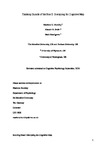Thinking Outside of the Box II: Disrupting the Cognitive Map
| dc.contributor.author | Buckley, M | |
| dc.contributor.author | Smith, Alastair | |
| dc.contributor.author | Haselgrove, M | |
| dc.date.accessioned | 2018-11-20T17:52:58Z | |
| dc.date.issued | 2019-02 | |
| dc.identifier.issn | 0010-0285 | |
| dc.identifier.issn | 1095-5623 | |
| dc.identifier.uri | http://hdl.handle.net/10026.1/12844 | |
| dc.description.abstract |
A number of influential spatial learning theories posit that organisms encode a viewpoint independent (i.e. allocentric) representation of the global boundary shape of their environment in order to support spatial reorientation and place learning. In contrast to the trial and error learning mechanisms that support domain-general processes, a representation of the global-shape of the environment is thought to be encoded automatically as part of a cognitive map, and without interference from other spatial cues. To date, however, this core theoretical assumption has not been appropriately examined. This is because previous attempts to address this question have failed to employ tasks that fully dissociate reorientation based on an allocentric representation of global-shape from egocentric reorientation strategies. Here, we address this issue in two experiments. Participants were trained to navigate to a hidden goal on one side of a virtual arena (e.g. the inside) before being required to find the same point on the alternative side (e.g. the outside). At test, performing the correct search behaviour requires an allocentric representation of the global boundary-shape. Using established associative learning procedures of overshadowing and blocking, we find that search behaviour at test is disrupted when participants were able to form landmark-goal associations during training. These results demonstrate that encoding of an allocentric representation of boundary information is susceptible to interference from landmark cues, and is not acquired through special means. Instead, the results suggest that allocentric representations of environmental boundaries are acquired through the same kind of error-correction mechanisms that support domain-general non-spatial learning. | |
| dc.format.extent | 22-41 | |
| dc.format.medium | Print-Electronic | |
| dc.language | en | |
| dc.language.iso | en | |
| dc.publisher | Elsevier BV | |
| dc.subject | Spatial learning | |
| dc.subject | Navigation | |
| dc.subject | Boundary | |
| dc.subject | Overshadowing | |
| dc.subject | Blocking | |
| dc.title | Thinking Outside of the Box II: Disrupting the Cognitive Map | |
| dc.type | journal-article | |
| dc.type | Journal Article | |
| dc.type | Research Support, Non-U.S. Gov't | |
| plymouth.author-url | https://www.webofscience.com/api/gateway?GWVersion=2&SrcApp=PARTNER_APP&SrcAuth=LinksAMR&KeyUT=WOS:000456765900002&DestLinkType=FullRecord&DestApp=ALL_WOS&UsrCustomerID=11bb513d99f797142bcfeffcc58ea008 | |
| plymouth.volume | 108 | |
| plymouth.publication-status | Published | |
| plymouth.journal | Cognitive Psychology | |
| dc.identifier.doi | 10.1016/j.cogpsych.2018.11.001 | |
| plymouth.organisational-group | /Plymouth | |
| plymouth.organisational-group | /Plymouth/Faculty of Health | |
| plymouth.organisational-group | /Plymouth/Faculty of Health/School of Psychology | |
| plymouth.organisational-group | /Plymouth/REF 2021 Researchers by UoA | |
| plymouth.organisational-group | /Plymouth/REF 2021 Researchers by UoA/UoA04 Psychology, Psychiatry and Neuroscience | |
| plymouth.organisational-group | /Plymouth/Users by role | |
| plymouth.organisational-group | /Plymouth/Users by role/Academics | |
| plymouth.organisational-group | /Plymouth/Users by role/Researchers in ResearchFish submission | |
| dc.publisher.place | Netherlands | |
| dcterms.dateAccepted | 2018-11-14 | |
| dc.rights.embargodate | 2019-2-12 | |
| dc.identifier.eissn | 1095-5623 | |
| dc.rights.embargoperiod | Not known | |
| rioxxterms.versionofrecord | 10.1016/j.cogpsych.2018.11.001 | |
| rioxxterms.licenseref.uri | http://www.rioxx.net/licenses/all-rights-reserved | |
| rioxxterms.licenseref.startdate | 2019-02 | |
| rioxxterms.type | Journal Article/Review |


